 This newsletter aims to update and inform people about the Herefordshire Natural Flood Management (NFM) project which is being delivered by Herefordshire Council within seven priority sub-catchments.
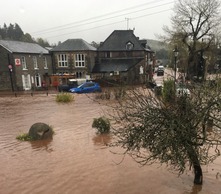
Many traditional methods of reducing flood risk involve hard engineered solutions such as building flood walls and embankments, which prevent the water spilling out of the channel in vulnerable areas such as towns and cities. However, this technique is not suitable for all locations, such as many villages within Herefordshire.
The Herefordshire Natural Flood Management (NFM) Project seeks to work in such locations and reduce flood risk using more natural techniques. By slowing the flow of water through a catchment e.g. by intercepting surface water flow pathways or by creating temporary water storage areas, it's possible to reduce the flood peak and the risk of properties flooding. Identifying locations which the flood water can spill out of the river channel and re-connect with it's floodplain can also help to reduce the flood risk.
Over the last year, landowners and farmers within the seven priority sub-catchments (mapped below) have been working with project funded Catchment Advisors at the Wye and Usk Foundation and Severn Rivers Trust to identify opportunities to slow the flow. To date, around £28,000 has been paid to landowners through the Herefordshire NFM Construction Grant Scheme to implement NFM measures which are helping to reduce the flood risk and lots more NFM work is planned to be delivered soon! This builds on the NFM work delivered between 2018-2021 through the River Wye and Lugg NFM Pilot Project.
|
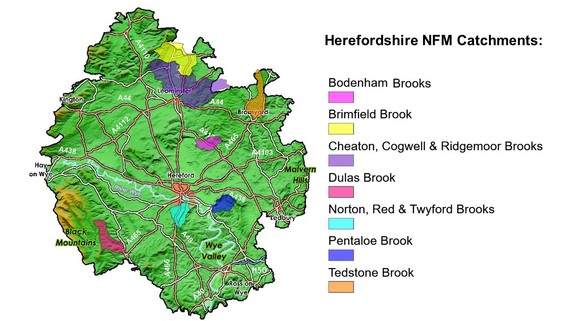 NFM works delivered in the past year:
-
Surface water flow pathways interrupted, slowing the flow of water through the catchment - 476 m fencing and 325 m new hedging
-
Riparian buffer strips created, increasing surface roughness, protecting banks from livestock poaching, reducing sediment loading into watercourse and slowing the flow of water - 1,058 m fencing (350 m part of enhanced wetland project)
-
New woodland areas - 1,233 trees planted, 365 m of fencing protecting new woodland areas
-
Soil improvement works, increasing infiltration into the soil, reducing surface water runoff and helping slow the flow of water - 52.5 ha grassland aeration, 14.35 ha grassland sward lifting
-
Enhanced existing wetland area through installation of 2 leaky dams, riparian tree planting (1,233 trees) and riparian buffer strip creation (350 m fencing). These measures are collectively helping slow the flow of water through this farm, helping to reduce the flood risk downstream.
-
Cover crops (31.66 ha) - helping protect the soil as well as improving the soils ability to hold and transport water, resulting in reduced surface water runoff
-
Species rich meadow created (0.7 ha) - meadows not only help to reduce surface water runoff, they also help to increase infiltration into the soil and slow the flow of water.
-
Landowner innovation - 7.5 ha direct drilling of autumn crops, helping to reduce soil compaction and subsequent surface water runoff.
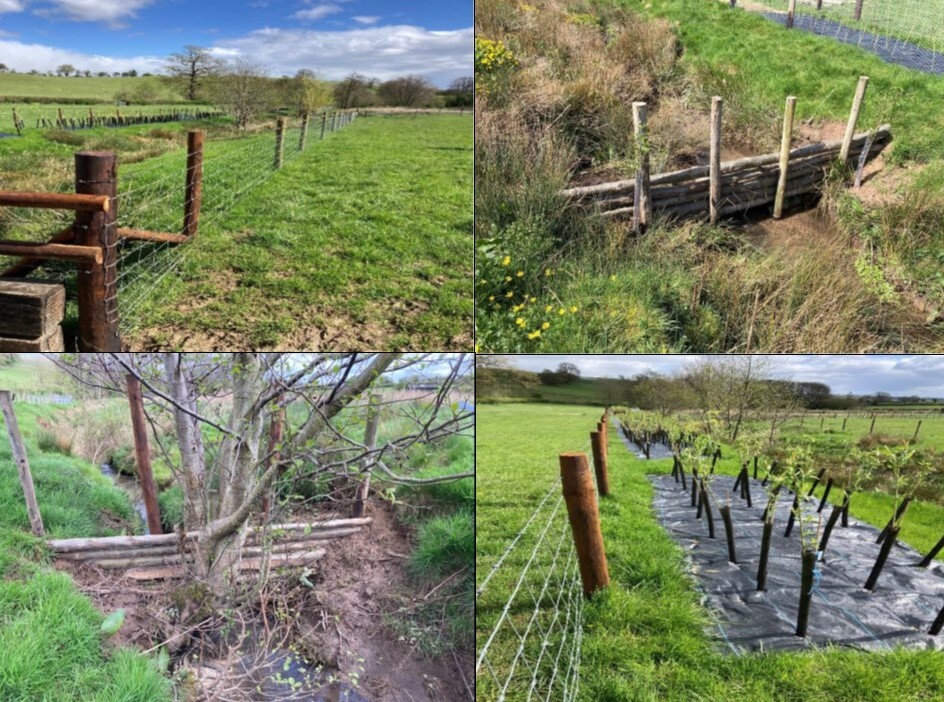 NFM works related to enhancement of existing wetland area (source: NFM Construction Grant Scheme recipient)
Seeking to learn from other NFM projects and share best practice, members of the Herefordshire NFM Steering Group visited the Stroud Valleys NFM project, which has been active since 2014 and has delivered over 1,000 NFM interventions, resulting in 25% of the project's catchment area draining through NFM features. The project's success has been demonstrated through their monitoring of the Slad Brook; monitoring has shown that the NFM works in this catchment have helped to reduce the peak river level by 1m (between two most comparable recent heavy rainfall events).
By visiting several sites, the group were able to see a variety of NFM measures/projects in action, observing how the features had bedded into the landscape over time and discussing their effectiveness at slowing the flow of water and reducing flood risk. Features such as an earth bund located at the bottom of a steeply sloping agricultural field had proven an effective method of reducing runoff as well as providing temporary flood storage areas.
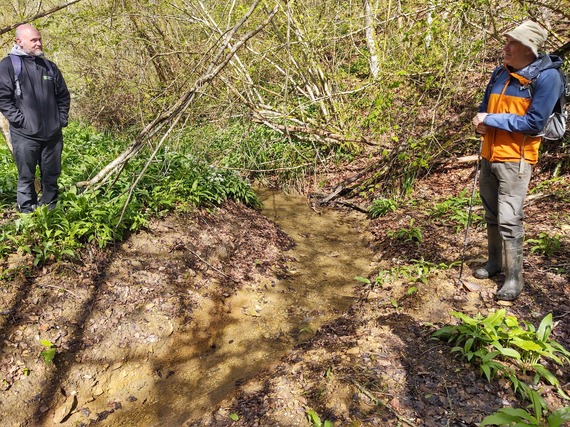 Disconnected and diverted perched watercourse, now flowing into wetland area connected to groundwater aquifer - Stroud Vallye NFM Project
One of the highlights of the day was a trip to see the recently implemented groundwater NFM project site near Horsley. Here the team have disconnected and re-naturalised a perched channel, re-directing water into an existing wetland area which is connected to a groundwater aquifer. During times of flooding, water flows through the re-naturalised channel, before entering the vegetated wetland area, which not only slows the flow of water due to increased surface roughness, but also provides opportunities for water to infiltrate into the aquifer and disperse onto the floodplain, helping reduce the volume of water that flows downstream. Groundwater monitoring equipment and river flow monitoring stations have been installed across the site to gather the data needed to quantify the benefits and impacts of this type of NFM project.
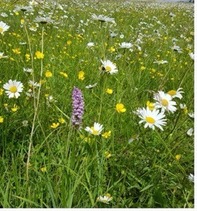
When people think nostalgically of the English countryside in summer, images of flower filled hay meadows often spring to mind. However, these are rapidly disappearing habitats with other 97% of our species rich hay meadows having been lost since the 1940s. Herefordshire Meadows has been working alongside farmers across the county for the past 5 years to restore and create new species rich grasslands across Herefordshire.
|
Recently, some of this restoration work has been supported by Herefordshire Council’s NFM project as it is acknowledged that diverse grasslands have incredible water storage and regulation capacities. In fact, a study carried out by USDA calculated that for each additional 1% of soil organic matter (SOM) in the soil, up to 1.5 Olympic swimming pools worth of water (185,000l) per ha are stored. If we consider that deep rooted, species rich grasslands can have SOM which are sometimes 5 times higher than species poor grasslands, the benefits in terms of water regulation and flood prevention become very clear.
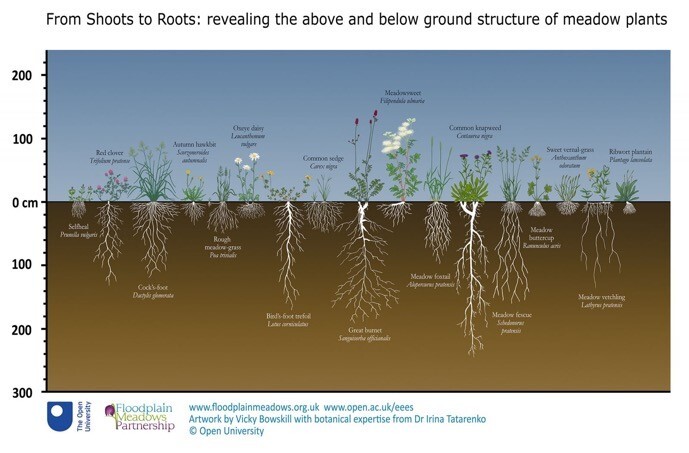 Species rich grasslands also have many other benefits including;
- Increased levels of biodiversity both above and below ground.
- Increased carbon capture and storage.
- Improved animal health, wellbeing and meat quality.
- Proven mental health benefits from exposure to nature filled fields.
Meadows don’t have to be massive and everyone can get involved by creating mini meadows in their back gardens or even in a flower pot. Plantlife’s No Mow May and Let it Bloom June campaigns are encouraging everyone to leave a bit of their lawns uncut to provide space for wildlife and stepping stones to help birds and insects move across the wider landscape.
If you have a larger area of species poor grassland and would be interested in increasing its diversity for all the above reasons then do get in touch with the Herefordshire Meadows Team (info@herefordshiremeadows.org.uk) and we can offer advice and signposting to grant support where available. We also have lots of helpful resources on our website www.herefordshiremeadows.org.uk
Article written by: Herefordshire Meadows
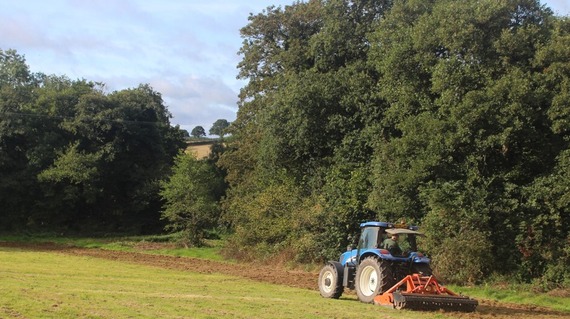 Preparing a meadow restoration site for seeding using a power harrow
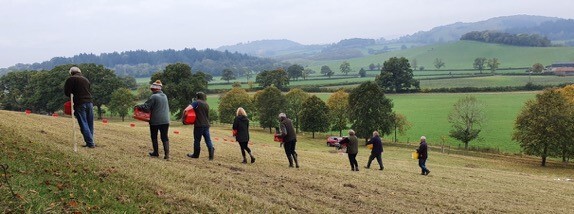 Seeding a new meadow with a group of local volunteers
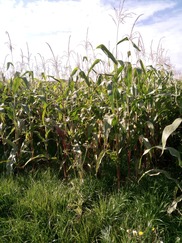
Get free tailored NFM Advice
Catchment Advisors from the Wye and Usk Foundation and Severn Rivers Trust are available to give free tailored advice about the NFM opportunities on your land. The advisors are also able to advise and support you in securing funding to deliver the recommended NFM opportunities.
If you'd like to get some advice or find out more, please email: nfm@herefordshire.gov.uk
|
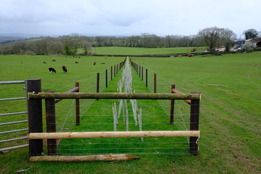
Get funding to deliver NFM
The Herefordshire NFM Construction Grant Scheme offers financial support to landowners within the seven NFM Catchment areas to deliver NFM measures on their land.
Apply now to get funding for NFM projects containing any of the measures detailed in the table below.
|
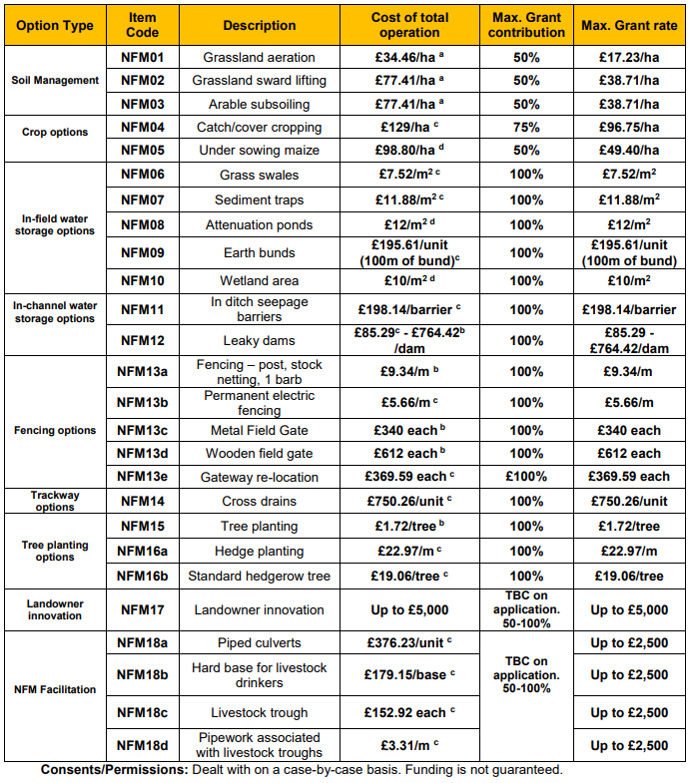 NFM Construction Grant Scheme payment rates (June 2024) - rates checked and correct on 15 May 2024
Source of Rates:
a National Association of Agricultural Contractors (NAAC) Contracting prices.
b England Woodland Creation Offer (EWCO) rates.
c Countryside Stewardship rates 2023.
d Based on local information and experience gathered through the Pilot Project or from our Project partners
Past events - what's been going on?
Brimfield NFM drop in session - Severn Rivers Trust
 |
|
To launch the start of their NFM advisory work within the Brimfield brook catchment, on 23 May 2024, Severn Rivers Trust hosted an NFM drop in session at Orleton Village Hall.
Thanks to everyone who attended the event, it was great to see so many people there, with many leaving contact details and asking to have a follow up visit to discuss the NFM opportunities on their land. Thanks also go to Orleton Parish Council and Orleton Village Hall for helping host the event.
|
Upcoming events - come and join us!
Flood Groups Meeting - 16th July 2024

Following on from our successful initial event in November 2023, if you’re part of a flood group, interested in joining one, or considering establishing a flood group in your area, then come to our next Herefordshire Flood Groups meeting on 16 July 2024.
For more details and to register, see the Eventbrite page.
|
Key contacts:
|